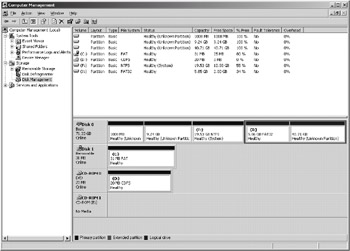Understanding Partitioning
Chances are, if you're reading this book, your PC already has Windows installed on it. This won't present a problem. In most cases, SUSE Linux can live happily alongside Windows in what's called a dual-boot setup, where you can choose at startup which operating system to run. However, installing SUSE Linux means that Windows must make certain compromises. It needs to cohabit your hard disk with another operating system—something it isn't designed to do.
The main issue with such a situation is that Windows needs to shrink and make some space available for SUSE Linux (unless you install a second hard disk, which we discuss later). SUSE Linux isn't able to use the same file system as Windows, and it needs its own separately defined part of the disk, which is referred to as a partition. All of this is handled automatically by the SUSE Linux installation routine, but it's important that you know what happens.
All hard disks are split into partitions, which are large chunks of the disk created to hold operating systems (just like a large farm is partitioned into separate fields). A partition is usually multiple gigabytes, although it can be smaller. You can view your disk's partitions using the Disk Management tool in Windows XP and Windows 2000, as shown in Figure 4-1. You can access this tool by opening Control Panel, clicking the Administrative Tools icon, selecting Computer Management, and then choosing Disk Management.

Figure 4-1. You can view your disk’s partitions using Windows XP’s Disk Management tool.
On most desktop PC systems, there's just one partition, unless the user has specifically created new partitions. As I mentioned, SUSE Linux needs a partition of its own. During installation, SUSE Linux needs to shrink the main Windows partition and create a fresh partition alongside it (actually, it creates two partitions; the extra one is used to hold the swap file).
In addition, the SUSE Linux installation routine writes a new boot sector (also known as a boot loader). This is a small program at the very front of the disk that runs a separate program that lets you choose between operating systems (and therefore partitions) when you first boot up.
| Note | Not all Linux distributions have the ability to repartition the hard disk. In fact, at the time of writing, it's pretty rare. Most expect to simply take over the entire hard disk, wiping Windows in the process (although they'll always ask the user the confirm this beforehand). The ability to repartition a disk is just one of the reasons that SUSE Linux is among the best Linux distributions currently available. |
Of course, SUSE Linux can't shrink a Windows partition that is packed full of data, because there will be no space left for it to reclaim.
One of the benefits of dual-booting Linux and Windows is that SUSE Linux automatically lets you access the files on the Windows partition. This is quite handy and facilitates the easy exchange of data. If the Windows partition is FAT32—used on Windows 95, 98, Me, and (sometimes) XP—then SUSE Linux can both read and write files to the partition. However, if the file system is NTFS—used with Windows NT, 2000, and (sometimes) XP—then SUSE Linux will make the file system available as read-only. Because of this, you might consider converting your NTFS Windows partition to FAT32 before you install SUSE Linux. Doing so means you lose some of the security and performance features of NTFS, however.
Microsoft doesn't include a tool that lets you do this automatically, but third-party disk partitioning programs like Symantec's Partition Magic (www.symantec.com) are able to do so.
EAN: 2147483647
Pages: 293